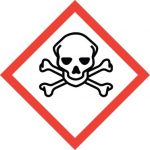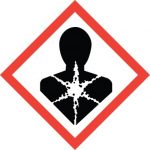1. IDENTIFICATION
Name: Thorium Chloranilate
Formula: ThC12Cl4O8•3H2O
CAS RN: [62654-18-6]
Relevant identified uses of the substance or mixture and uses advised against.
Supplier
IBI Labs
3495 N. Dixie Hwy. Unit # 8
Boca Raton, FL 33431
Tel: 561-826-0061 Fax: 561-892-8450
Emergency Telephone Numbers
INFOTRAC
USA & Canada contact number: 1-800-535-5053
International contact number: 1-352-323-3500
Properties
- Appearance: Grey-white hexagonal crystals
- Odor: Acetone-like
- Solubility: Water-soluble
- Flammability (solid, gaseous): Not flammable
- Chemical Characterization: Substances
2. HAZARDS IDENTIFICATION
Classification of The Substance or Mixture
GHS06 Skull and Crossbones
H301 Toxic if swallowed.
H331 Toxic if inhaled.
GHS08 Health hazard
H373 May cause damage to organs through prolonged or repeated exposure.
Classification According to Directive 67/548/EEC or Directive 1999/45/EC
Very toxic.
Very toxic by inhalation and if swallowed.
Danger of cumulative effects.
Information concerning hazards for humans and the environment: Not applicable.
Label Elements
Labeling according to EU guidelines: The product has been classified and marked following directives on hazardous materials.
Code letter and hazard designation of product: Very toxic
Risk Phrases
- Very toxic by inhalation and if swallowed.
- Danger of cumulative effects.
Safety Phrases
- Keep away from living quarters.
- Keep the container in a well-ventilated place.
- When using do not eat, drink, or smoke.
- Wear suitable protective clothing.
Classification System
NFPA ratings (scale 0 – 4):
4
0
0
Health = 1
Fire = 1
Reactivity = 0
HMIS-ratings (scale 0 – 4):
HEALTH
FIRE
REACTIVITY
4
0
0
Health = 4
Fire = 0
Reactivity = 0
Other Hazards
Results of PBT and vPvB assessment:
PBT: Not applicable.
vPvB: Not applicable.
3. FIRST AID MEASURES
General information:
- Seek medical attention immediately.
- Remove any clothing soiled by the product. Remove the breathing apparatus only after contaminated clothing has been completely removed.
- In case of irregular breathing or respiratory arrest provide artificial respiration.
After inhalation:
- Supply fresh air or oxygen.
- In case of unconsciousness, place the patient stably inside a position for transportation.
After skin contact: Immediately wash with water and soap, and rinse thoroughly.
After eye contact: Rinse eyes for several minutes under running water.
After swallowing: Do not induce vomiting.
4. FIREFIGHTING MEASURES
Extinguishing Media
Suitable extinguishing agents:
- CO2, extinguishing powder, or water spray.
- Fight larger fires with water spray or alcohol-resistant foam.
Advice for Firefighters
Protective equipment: Mouth respiratory protective device.
5. ACCIDENTAL RELEASE MEASURES
Release Measures
Personal precautions, protective equipment, and emergency procedures: Not required.
Environmental precautions: Do not allow to enter sewers, surface, or groundwater.
Methods and material for containment and cleaning up:
- Dispose of contaminated material as waste according to Section 13.
- Ensure adequate ventilation.
6. HANDLING AND STORAGE
Handling
Precautions for safe handling:
- Thorough dedusting.
- Ensure good ventilation and exhaustion at the workplace.
- Open and handle the receptacle with care.
Information about protection against explosions and fires: Keep respiratory protective devices available.
Storage: Keep the receptacle tightly sealed.
7. EXPOSURE CONTROLS AND PERSONAL PROTECTION
Control Parameters
Components with limit values that require monitoring at the workplace: Not required.
Additional information: The lists that were valid during the creation were used as a basis.37.0
Exposure Controls
At any detectable concentration: Any self-contained breathing apparatus with a full facepiece operated in a pressure-demand or other positive-pressure mode.
Any supplied-air respirator with a full facepiece operated in a pressure-demand or other positive-pressure mode or other positive-pressure mode with an auxiliary self-contained breathing apparatus operated in pressure-demand or other positive-pressure mode.
Escape – any air-purifying, full-facepiece respirator with a high-efficiency particulate filler.
Any appropriate escape-type, self-contained breathing apparatus.
General protective and hygienic measures:
- Keep away from foodstuffs, beverages, and feed.
- Immediately remove all soiled and contaminated clothing.
- Wash hands before breaks and at the end of work.
- Store protective clothing separately.
Breathing equipment: In case of brief exposure or low pollution use a respiratory filter device. In case of intensive or longer exposure use a respiratory protective device that is independent of circulating air.
Protection of hands: The glove material must be impermeable and resistant to the product, the substance, and the preparation. Due to missing tests, no recommendation for the glove material can be given for the product, the preparation, and the chemical mixture. Selection of the glove material on consideration of the penetration times, rates of diffusion, and the degradation
The selection of appropriate gloves depends on the material, while the quality standards may vary among manufacturers.
Penetration time of glove material: The exact break-through time must be found out by the manufacturer of the protective gloves and must be observed.
Eye protection: Not required.
Clothing: Employees handling radioactive substances should wear disposable overgarments, including head and foot coverings. These garments are also recommended even if the employee uses a “glove box” containment system. Certain clothing fibers may be useful in dosimetry so clothing should be kept.
Firefighting and Other Immediately Dangerous to Life or Health Conditions
Use any self-contained breathing apparatus with a full facepiece respirator and a high-efficiency particulate filter.
Use any supplied air respirator with a full facepiece operated in a pressure-demand or other positive-pressure mode or other positive-pressure modes with an auxiliary self-contained breathing apparatus operated in pressure-demand or other positive-pressure modes.
8. REACTIVITY
Chemical Stability
Stable under recommended storage conditions.
Thermal decomposition and conditions to be avoided: No decomposition if used according to specifications.
Possibility of hazardous reactions: No dangerous reactions are known.
Hazardous decomposition products: No dangerous decomposition products are known.
9. TOXICOLOGICAL INFORMATION
Information on Toxicological Effects
Skin: No irritant effect.
Eye: No irritating effect.
Sensitization: No sensitizing effects known.
Carcinogenic Categories
IARC (International Agency for Research on Cancer): Substance is not listed.
NTP (National Toxicology Program): Substance is not listed.
10. ECOLOGICAL INFORMATION
Toxicity
Water hazard class 2 (Self-assessment):
- Hazardous for water.
- Do not allow the product to reach groundwater, watercourse, or sewage system.
- Danger to drinking water if even small quantities leak into the ground.
Results of PBT and vPvB assessment
PBT: Not applicable.
vPvB: Not applicable.
Other adverse effects: No further relevant information is available.
11. WASTE TREATMENT METHODS
Recommendation:
- Thorium Chloranilate should not be disposed of with household garbage.
- Do not allow the product to reach the sewage system.
Waste from residues/unused products: Waste disposal must follow appropriate Federal, State, and local regulations. If unaltered, this product may be disposed of by treatment at a permitted facility or as advised by your local hazardous waste regulatory authority. Residue from fires extinguished with this material may be dangerous.
Contaminated packaging: Do not reuse empty containers and dispose of them as unused products.
12. TRANSPORTATION
UN-Number
DOT, ADR, IMDG, IATA: UN2910
UN proper shipping name
DOT: Radioactive material, excepted package-limited quantity of material
ADR: 2910 Radioactive material, excepted package-limited quantity of material
IMDG, IATA: RADIOACTIVE MATERIAL, EXCEPTED PACKAGE – LIMITED QUANTITY OF MATERIAL
Transport hazard classes
DOT, ADR: Class 7 Radioactive material.
Environmental hazards
Marine pollutant: No
Special precautions for user: Warning: Radioactive material
Transport in bulk according to Annex II of MARPOL73/78 and the IBC Code: Not applicable.
UN “Model Regulation”: UN2910, Radioactive material, excepted package-limited quantity of material, 7
Packing Group:
The classification of substances with multiple hazards must be determined following the criteria presented in the regulations mentioned above. Due to the various quantities and combinations of materials being shipped at one time, the information above must be determined based on the characteristics of the specific shipment.
13. SAFETY, HEALTH, AND ENVIRONMENTAL REGULATIONS/LEGISLATION SPECIFIC TO THE SUBSTANCE OR MIXTURE
Sara
Section 355 (extremely hazardous substances): The substance is not listed.
Section 313 (Specific toxic chemical listings): Substance is not listed.
TSCA (Toxic Substances Control Act): Substance is not listed.
Proposition 65
Chemicals known to cause cancer: Substance is not listed.
Chemicals known to cause reproductive toxicity for females: Substance is not listed.
Chemicals known to cause reproductive toxicity for males: Substance is not listed.
Chemicals known to cause developmental toxicity: Substance is not listed.
Carcinogenic categories
EPA (Environmental Protection Agency): Substance is not listed.
TLV (Threshold Limit Value established by ACGIH): Substance is not listed.
NIOSH-Ca (National Institute for Occupational Safety and Health): Substance is not listed.
OSHA-Ca (Occupational Safety & Health Administration): Substance is not listed.
Product-Related Hazard Information
The product has been classified and marked following directives on hazardous materials.
Hazard symbols: Very toxic
Risk phrases:
Very toxic by inhalation and if swallowed.
Danger of cumulative effects.
Chemical safety assessment: A Chemical Safety Assessment has not been carried out. This information is based on our present knowledge. However, this shall not constitute a guarantee for any specific product features and shall not establish a legally valid contractual relationship.
Abbreviations and Acronyms
ADR: Accord européen sur le transport des marchandises dangereuses par Route (European Agreement concerning the International Carriage of Dangerous Goods by Road).
IMDG: International Maritime Code for Dangerous Goods.
DOT: US Department of Transportation.
IATA: International Air Transport Association.
ACGIH: American Conference of Governmental Industrial Hygienists.
EINECS: European Inventory of Existing Commercial Chemical Substances.
CAS: Chemical Abstracts Service (a division of the American Chemical Society).
NFPA: National Fire Protection Association (USA).
HMIS: Hazardous Materials Identification System (USA).
14. OTHER INFORMATION
IBI Labs requires that those who receive their materials comply with 29 CFR 1910.1200(h), which mandates that employers provide employees with effective information and training about hazardous chemicals in their workplace.
The contents of this document are believed to be accurate as of the date of revision and are provided in good faith. However, it is recommended that recipients use this information as supplementary and exercise caution and judgment regarding its accuracy and suitability. Please note that IBI Labs cannot be held responsible for any damage, direct or indirect, that occurs because of using the information provided in this Safety Data Sheet.
IBI Labs makes no warranties, expressed or implied, including warranties of merchantability and fitness for a particular purpose. This information is provided without warranty, and any use of the product that does not conform to this Safety Data Sheet, or that is used in combination with any other product or process, is the user’s responsibility.
Revision Date: 07/03/2024



